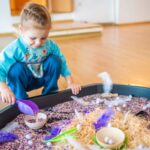New Active Birth is a comprehensive guide that helps mothers to be to prepare for a natural childbirth in order to reduce the need for medical intervention during labour. The book introduces the reader to the concept of active birth and takes them on a journey through the stages of their pregnancy and labour right through to postnatal. Explaining how yoga based exercises can help both during pregnancy and labour helping the mother to remain in control. It instils confidence so that women are empowered to have the positive birth they hope for.
New Active Birth was published in 1989 which is reflected in the style of the book. Modern photography and illustrations would change the initial feel and look of this book and draw new readers to want to read it (cf. Freedman Birth and Beyond which has clear modern photography) [1]. Nevertheless the format of the book is well laid out; it is easy to refer to a chapter and then a sub heading to find specific information.
Balaskas style of writing and use of medical terminology and jargon doesn’t always make it easy to comprehend unless you have a medical understanding that is more advance than would be expected in the general public. Although the book relevant to all pregnant women as she has covered water births, home births and hospital births it is also of particular interest for women who know that they are having a hospital birth to make them aware that they are still able to have an active birth and have control of their labour.
The opening paragraphs on active birth are empowering, explaining why an active birth is important and how it can help with even the most difficult births; turning them in to a positive experience. This is what draws the reader into the book so that they can discover how they can achieve this for their own births; however the remainder of the chapter is over detailed. The information on the historical background and ethnological evidence is very interesting, but on the whole there was too much information and detail, and the book could have perhaps have been more concise. The most important information in the first chapter is ‘why an active birth is better providing the reader with the detail as to why an active birth is advantageous and the benefits this will have for the Mother and baby. Although this section was detailed it explained concisely the benefits with supporting background material and factual information.
Balaskas also details in this chapter ‘what is wrong with obstetrically managed birth’. This could be taken in two ways; it could leave a negative impression on the reader causing them to worry about the side effects of medical intervention on themselves and their baby. As Balaskas explains sometimes circumstances beyond our control mean that medical intervention is necessary, however the severity of the side effects could concern the reader. This could cause them to feel anxious about the use of medical intervention during their labour, going against the principles of reducing anxiety and stress which would in turn have an effect on their adrenaline levels. On the other hand this knowledge could also empower the reader to have an active birth so that they can avoid medical intervention in the first place.
The overall body of the book leading up to labour and birth offers many similarities to Daisy Birthing classes. Balaskas covers active birth education in extensive detail. She looks at the pregnant body, detailing all of the vital organs and muscles used during pregnancy and labour and explain how they operate. She also explains the different stages of labour very succinctly.
Balaskas also covers Yoga-based exercises that can be used both throughout pregnancy and during labour, as do Daisy Birthing classes. The photographs of the yoga movements and the detailed explanations of how to conduct the moves are very clear. Balaskas mentions some of the contraindications and provides ‘a word of warning’ however she could have reiterated the contraindications alongside the relevant moves. She also does not make any reference to Symphysis Pubis Dysfunction (SPD) which is a common pregnancy ailment and some of the positions that she features such as the initial seated segment, also the advanced posture which abducts the pelvis and would cause discomfort to someone suffering with SPD.
Balaskas dedicates a chapter to breathing, however in comparison to her coverage of active birth education and yoga movements she could have talked in more detail about breathing as it is such a fundamental element. Although there is further reference throughout the book to breathing, the chapter on breathing could have discussed the correct ways to breathe and also the different breaths required for the different stages of labour in more detail. Balaskas does talk about breathing in the ‘labour and birth’ chapter, but one of the key differences between Daisy Birthing and Balaskas breathing techniques is the change of breaths during established labour and the 2nd stage. Balaskas makes no reference to changing from deep breathing. As we know, this isn’t always possible to maintain in established labour due to the length of contractions, which is why in established labour Daisy Birthing classes recommend a change in breathing to the escalator breath. In the 2nd stage of labour Daisy Birthing classes also recommend a change in breathing to the bearing down breath. Balaskas also talks about feeling the need to scream or cry out during the latter stages of labour and that we should not suppress these urges. This is correct to an extent, as if you were to suppress the urges it would be likely that you would find yourself holding your breath and clenching your jaw to hold your cry in. This closes your body and would be counterproductive for labour and allowing your body to open and release. It is however also important to remain focussed. If we allow ourselves to openly scream and cry out then our focussed breathing may not be maintained. In the bearing down breath we continue focussed on our breathing but we are also releasing sound as well, sending both the sound and the breath down to our tummy. In doing so our breathing and mindset remains focussed.
Balaskas make some references to meditation and mindset, but there is no real focus on relaxation and self hypnosis. She could have highlighted in more detail the benefits of self hypnosis as does Daisy Birthing, [2] by instilling confidence so that you have a positive mindset for labour and can avoid adrenaline levels rising [3]. This is a key element and the 3rd rule of active birth. If we allow our fear or flight reflex to kick in, adrenaline levels will begin to rise and our muscles will not work as effectively as they should. Oxygen is sent to our vital organs and the uterus would not receive the oxygen it requires to work efficiently. Therefore it would be difficult to have the positive birth we were hoping for as the birth would become painful and medical intervention may then be required. Grantly Dick-Read covers the cycle of fear-tension-pain comprehensively in his book Childbirth without fear [4] where he ensures women are educated about the birthing process but also provides techniques for remaining relaxed so that they can counteract this cycle.


